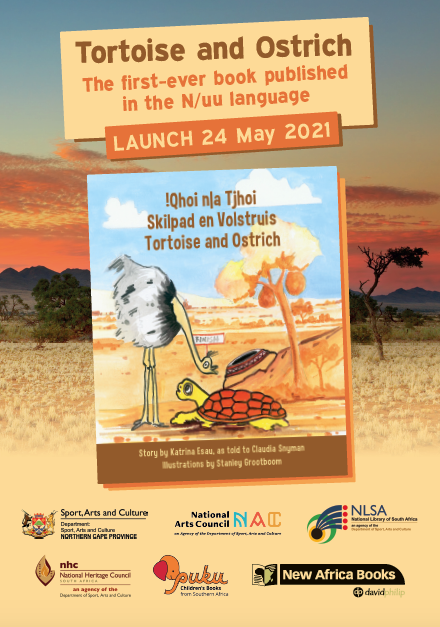9 reasons you should get a copy of the first ever N/uu language children’s book, Tortoise and Ostrich


- Ostensibly for children, Tortoise and Ostrich is actually a little piece of history in the making, as this is the first book published in the N/uu language. Why is this significant? N/uu is an ancient, endangered language, and sharing this story is a small, but important step towards keeping it alive.
- According to Unesco’s Atlas of the World’s Languages in Danger at least 43% of the estimated 6000 languages spoken in the world are endangered. By owning a copy of this book, you’re contributing to the preservation of an endangered language.
- The story is told by Katrina Esau, one of the last speakers of the N/uu language. It’s one of the San folk tales she was told as a child, sitting around the fire, listening to her family telling the same stories they had heard as children, keeping their oral story-telling tradition alive. Fondly known as Queen or Ouma, Katrina lives in Rosedale, outside Upington in South Africa’s Northern Cape province.
- The story was written in N/uu and Afrikaans by Ouma Katrina’s granddaughter, Claudia Snyman. The Afrikaans version was edited and translated into English by internationally celebrated writer and poet, Diana Ferrus.
- The book was beautifully illustrated by acclaimed South African artist, Stanley Grootboom.
- For the first print run, the book was published trilingually in N/uu, English and Afrikaans. Imagine reading this to the children in your lives – while exploring the world of the ostrich and the tortoise, you also get to explore the look and feel of this nearly lost language. Additional print runs have been planned to include other official South African languages like Setswana, and Nama which is also spoken widely in the Northern Cape.
- At the age of 88, Ouma Katrina is still working tirelessly to ensure the survival of her mother tongue. She teaches N/uu phrases and songs to between thirty and forty children from her community, and the neighbourhood, in language classes that take place three times a week for about two hours a day.
- Buying a copy of this book will go towards supporting all Ouma Katrina’s efforts, and will hopefully make the publishing of a second story possible.
- In 2020, Ouma Katrina was honoured as a South African Living Human Legend for her ‘high degree of knowledge and skills to perform or recreate specific elements of the intangible cultural heritage’. Ouma Katrina has also been awarded the Order of the Baobab in Silver for her excellent contribution to the preservation of a language that is facing a threat of extinction.
In short, this is exciting. It’s big news. If you’re reading this, you should be sharing it. It’s a momentous occasion worthy of conversation and action. Go ahead, get the book, and contribute to the preservation of an endangered, ancient language.
The Ostrich and the Tortoise was published in April 2021 by New Africa Books, with an official launch taking place on 24 May.
Award winning author and translator, and Managing Editor at Puku Children’s Literature Foundation, Lorato Trok chatted to us before the launch about the the making of the book. She has been a champion of this project from the get go, getting behind the idea after encouraging Ouma Katrina to attend a My Language, My Heritage writing workshop hosted in the Northern Cape a few years ago, and then getting to know her on a personal level.
Before this children’s book came into existence, work had already started on documenting the language and creating an orthography, including alphabet charts and language posters, that Ouma Katrina could use when teaching her N/uu classes, and to create a legacy of information. This was done primarily by Sheena Shah and Matthias Brenzinger, while working at the Centre for African Language Diversity (CALDi) at the University of Cape Town, in conjunction with Ouma Katrina, Claudia Snyman and David van Wyk, a member of the Royal Khoisan Heritage Council. You can read more about this extensive project here on Shah’s blog, and in this Sunday Time’s article, ‘The last hope for N/uu, a language on the brink of extinction’.
Having designed the orthography, Shah and Brenzinger played an integral part in the publishing of the children’s book, acting as editors for Snyman’s N/uu text, as there is literally no one else on earth who could do this.
Trok’s enthusiasm for the book is contagious, but there is also a sense of urgency to it. She explains why you should get the book:
‘You will enjoy the traditional San story, and you should have this book as a keepsake. This is a rare language, can you imagine, having a book in your collection in a language that's only spoken by two people in the whole world, and in a language that is believed to be the oldest in the world, more than 2,500 years old. If you have that in your book collection, you've got a treasure in your hand. So I would say to people, run and get this book, so that if Ouma Katrina is no more, you will be part of history.’
According to Trok, the book is not openly licenced, it’s only available commercially at this stage, with sales from the books going towards funding Ouma Katrina’s ongoing work, and a second print run featuring other South African languages and N/uu. The initial print run was small, with the National Library purchasing 300 books to distribute in libraries in the Northern Cape. The rest of the books are available for purchase online at Book Circle Capital.




